Dublin and Lucan Steam Tramway / Dublin and Lucan Electric Railway
(Lucan and Leixlip Steam Tramway / Lucan and Leixlip Electric Railway)
History
Approval to build a 3ft-gauge steam tramway between Dublin and Lucan, circa nine miles to the west, was granted by the Privy Council on the 2nd November 1880; nine days later (on the 11th November 1880) the promoters formed a company — the Dublin and Lucan Steam Tramway Company — to raise the capital necessary to build and operate the tramway.
Worked commenced on the 23rd December 1880, with the first section — from Conyngham Road in Kingsbridge to Chapelizod, 1.75 miles away, opening on the 1st June 1881, and the section beyond to Palmerstown in November, at which point the company ran out of money. This situation was only rectified by means of a £10,000 loan from the Commissioners of Public Works. This enabled construction of the final section of the tramway, from Palmerstown to Lucan, services over the completed line only commencing some fifteen months later on the 20th February 1883.
The initial services were provided by an experimental combined steam tramcar, i.e., a single vehicle containing both the steam engine and a passenger compartment. The vehicle was built by Manlove, Alliott and Company of Nottingham, to the design of Edward Perrett, and appears to have been on loan with a view to purchase. It was seemingly the only vehicle available, as when it needed major modifications to its crank axles and bearings to withstand the heavy passenger loadings, services had to be suspended. The company had to wait for the first of its Kitson tram engines until 1882 (two were delivered that year, with one arriving in early 1883). Further Kitsons, essentially similar to the original three but more powerful, arrived in June and July 1884, and March 1887, by which time a proper freight service was being run.
On the 30th August 1899, a new company — the Lucan, Leixlip and Celbridge Steam Tramway Company — was granted an Order in Council to build around five miles of tramways, which were in effect extensions to the D&LST. However, only 1.5 miles was ever built, from the D&LSTCo's terminus at Lucan to Leixlip. It is unclear exactly when the extension opened, but it was certainly in use by June 1890. Although the LL&CSTCo bought a Kitson steam tram to work the line (in 1892), the engine was incorporated into the D&LSTCo fleet, as operation of the L&LCSTCo's line was always leased to the latter company.
The extension took the steam tramway — which was laid to one side of the road with grooved rail, flush with the road service — to its final size of 8.5 miles. At its eastern extremity in Conyngham Road, just twelve yards separated the tracks of the steam tramway from the tracks of the Dublin Tramways Company's horse tramway, though there was no physical connection as the latter was built to the Irish Standard Gauge (i.e., 5ft 3 ins). From the terminus, the line ran westwards along Conyngham Road, past the main depot, through Chapelizod, Palmerstown and Ballydowd to Lucan; from Lucan, the LL&CSTCo's line ran through Dodsborough to a terminus just a few yards short of Leixlip Bridge.
Passenger and freight loadings were healthy, so the D&LSTCo was able to pay reasonable dividends throughout the 1880s. By 1895, however, the grooved track was giving trouble, having been lightly laid, and having borne the brunt of heavy traffic, both tramway and other road users; freight services had already been suspended two years earlier, presumably to save the track. On the 12th February 1896, the company obtained an Order in Council to enable it to relay the tramway with much heavier girder rail, and on a raised formation, all to be paid for by the issue of debentures.
Although relaying of the track was started, it was soon interrupted by a dispute with the County Surveyor's Office over the positioning of the track at various points. It is assumed that work was eventually restarted, and that the entire line was then relaid, though it is hard to be sure, given that the company's attentions now turned to electric traction. After much discussion, an Extraordinary General Meeting was held on the 18th February 1898, at which it was agreed to raise the necessary finance to convert the line to electric traction. The company duly obtained an Order in Council (under the Light Railways Act) to carry out the conversion, and to change the gauge from 3ft to 3ft 6ins, and the name of the company to the Dublin and Lucan Electric Railway Company.
It is unclear why the LL&CSTCo did not throw in its lot with the D&LSTCo, so that the whole line could be converted. It is entirely possible that the company had its eye on various other electric tramway proposals that were being floated at the time, and which would potentially use its tracks; however, these schemes all came to naught. It certainly seems a little odd that services beyond Lucan were withdrawn in late October 1897, a development that could not have been for conversion work, as the latter required powers that the company did not obtain for another four months.
The new electric tramway — between Conyngham Road and Lucan — opened for business on the 8th March 1900 using five new electric tramcars. The latter were joined by a motorised former steam tram trailer and an electric locomotive (for goods haulage) in 1905, and a new double-deck tramcar in 1906.
Business was evidently reasonably good as the capital costs were completely paid off by 1910, though this appears to have been at the expense of the shareholders, who received no dividends during the decade, a situation that unbeknownst to them, was to persist for the entire lifetime of the D&LERCo.
A scheme to electrify the old Lucan to Leixlip tramway was eventually promoted in 1908; however, as the powers granted on the 2nd December 1910 — under the Lucan and Leixlip Electric Railway Order, 1910 — only authorised the construction of a mere 0.5 miles of tramway (between Lucan and Dodsborough) it seems that the promoters aspirations were very limited, i.e., to reach the Spa Hotel (at Dodsborough). The order also authorised the incorporation of a company (the Lucan and Leixlip Electric Railway Company) to build the line, as well as to lease the operation of the tramway. It is unclear when the tramway was opened, but probably in late summer 1911, as a formal lease arrangement with the D&ELRCo was signed on the 11th August 1911.
The tramway was significantly impacted by the Great War and the Irish War of Independence, and was taken over by the British Government in 1917 under the Defence of the Realm Act. Government control lasted through to the 14th August 1921, during which time wages were significantly increased, as were other operating costs. Whilst a few of the tramcars were rebuilt in 1917/18, the rest of the infrastructure, i.e., the track, was by now in pretty poor condition, and the company was in no position to finance its replacement from revenue, given that operating costs greatly outstripped income. The tramway had in effect only been kept running — between 1917 and 1921 —because the government subsidised it, so with termination of government control, the financial situation looked bleak. Results in 1922 were dire, the company only being kept from going under by £5000 compensation under the Irish Railways (Settlement of Claims) Act, 1921.
During 1924, the company had hoped that it could make a case for inclusion in the coming Irish railways amalgamation, but in the end it was excluded, as it was deemed to be more of a tramway. Overtures were also made, unsuccessfully, to the Dublin United Tramways Company, whose tracks the D&LER met at Conyngham Road, though unsurprisingly, the latter was not interested in a tramway that was not only of a different gauge, but which was also in need of very significant investment. If the greatly increased costs, dropping passenger numbers and worn-out infrastructure were not enough of a problem, the tramway was now subjected to unregulated motorbus competition, which caused its losses to escalate even further.
The company somehow struggled on through to the last week of January 1925, but with no saviour on the horizon, the only option was bankruptcy, the last tram running on the 29th January. There was, however, much local and municipal outrage, and clamour for the tramway's reinstatement, particularly as it had ultimately been put out of business by unregulated motorbus competition, the buses having purportedly damaged the local road surfaces to the tune of £50,000.
A liquidator was appointed on the 19th January 1926 to wind up the affairs of the D&LERCo, and after convoluted negotiations involving the Dublin Commissioners, Dublin Corporation and the DUTCo, the latter agreed to acquire both the D&LER and the L&LER. Naturally, the DUTCo did not agree to this course of action out of the goodness of its heart, but rather in return for various concessions from the authorities, chief amongst which was an undertaking from Dublin Corporation not to oppose its application for powers to run motorbuses, and a deferment of the corporation's right to buy the DUTCo's tramway system until the 31st December 1966.
The DUTCo reached agreement with the D&LERCo on the 7th December 1926, and the L&LERCo on the 4th January 1927. Powers to acquire, reconstruct and operate the tramway were obtained on the 13th May 1927, under the Dublin United Tramways (Lucan Electric Railways) Act, 1927. The DUTCo formally acquired the D&LERCo's assets on the 7th July 1927 (for £12,500), and those of the L&LERCo around the same time (for £800), reconstruction starting on the 2nd September that year to Irish Standard Gauge (5ft 3ins). The line was opened as far as Chapelizod on the 14th May 1928, and in full — to Lucan — on the 27th May 1928. The line beyond Lucan to Dodsborough was not reconstructed due to objections raised by Dublin County Council.
The tracks were now the same gauge as those of the DUTCo's, so the D&LER was now finally connected to the Dublin tramway system, services running to and from Dublin for the first time. Although ten new trams were built to operate the tramway, it was destined to last under twelve years, the DUTCo electing in the 1930s to close its entire tramway system in favour of motorbuses. The last tram over the Dublin and Lucan tramway ran on the 13th May 1940, motorbuses taking over services the next day,
Uniforms
Several reasonable quality photographs have survived that show staff of the Dublin and Lucan Steam Tramway Company. In common with the vast majority of steam tramway operators, drivers and firemen/stokers (always two in the case of the D&LSTCo) wore typical railway footplate-like attire, namely, cotton jackets and trousers, along with cotton, cloth or soft-topped caps. Neither the hats nor the jackets bore insignia of any kind. Conductors on the other hand appear to have been issued with waistcoats (with six metal buttons, of unknown pattern) and three-quarter length jackets with stand-up collars; it is unclear whether the latter carried any insignia. Caps were in a kepi-style and carried a prominent cap badge, an example of which has yet to come to light.
The photographic record for the electric era — during which the tramway was operated by the Dublin and Lucan Electric Railway Company — is unfortunately sparse indeed; it is therefore only possible to describe the uniform in the most general of terms. Motormen and conductors working the new electric services were issued with single-breasted jackets with lapels; up until 1914, the jackets were brown, and appear to have been devoid of insignia. It is unclear what style of cap was worn initially, but possibly tensioned-crown peaked caps; in later years, the caps carried a hatband, which appears to have borne system initials — 'D & L E R' — in block capitals, very possibly embroidered. Some photographs show crewmen wearing straw boaters, a common summer practice on the D&LER's near neighbour, the Dublin United Tramways Company.
At some point, the single-breasted jackets were superseded by new styles: photographs suggest that motormen were issued with double-breasted, lancer style tunics, with five pairs of buttons and stand-up collars, and conductors with double-breasted jackets with lapels. Conductor's jacket collars certainly bore lettering of some kind, most probably system initials, and perhaps an employee number.
Following the bankruptcy of the D&LER and closure of the system in 1925, the line remained dormant, eventually being relaid some two years later by the DUTCo. Staff working the services during this period would therefore have worn standard DETCo uniforms (see link).
It is currently unclear whether the D&LSTCo and the D&LER employed inspectors.
Further reading
For a history of this tramway, see: 'The Dublin, Lucan and Leixlip Steam Tramways and Electric Railways' by Alan T Newham, in the Tramway Review, Nos 32 (p222-232) and 33 (p3-19); Light Railway Transport League (1962). For an overview of the Irish tram scene, including the Dublin and Lucan, see 'Irish Trams' by James Kilroy; Colourpoint Books (1996).
Images
Steam tram drivers and conductors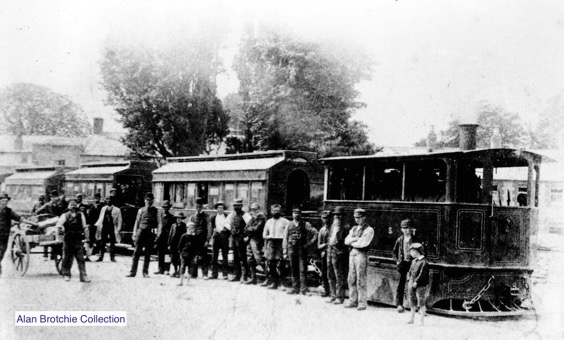
A busy scene with Dublin and Lucan Steam Tram Company No 5, a Kitson product delivered in 1884 — photo undated, but judging by the condition of the engine and the various types of headwear in evidence, probably taken in the late 1880s or early 1890s. The location is probably Lucan Village (with thanks to John Kelleher for the identification).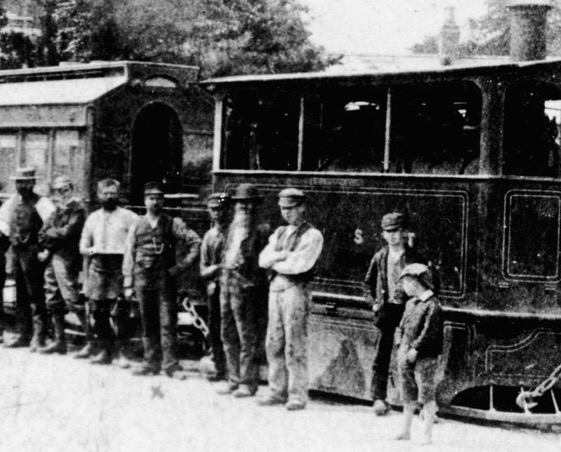
An enlargement of the above photograph showing some of the assembled men. The figure fourth from the left appears to be wearing a uniform waistcoat with a kepi-style cap, whilst two of the three central figures are possibly the engine driver and fireman/stoker.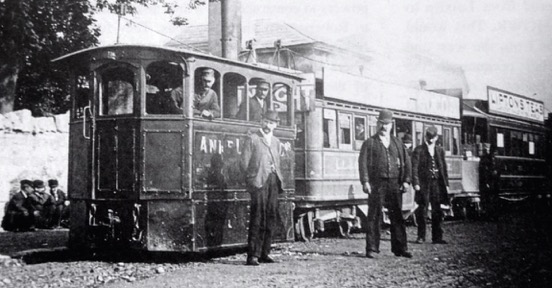
An unidentified Kitson, though seemingly one of the smaller engines in the stable, so probably either No 1, 2 or 3. The photo is thought to have been taken around 1895 at Conyngham, a date supported by the tired-looking condition of the first carriage — a vehicle of the Lucan, Leixlip and Celbridge Steam Tramway — which was effectively an extension of the D&LST opened in 1890. Author's Collection.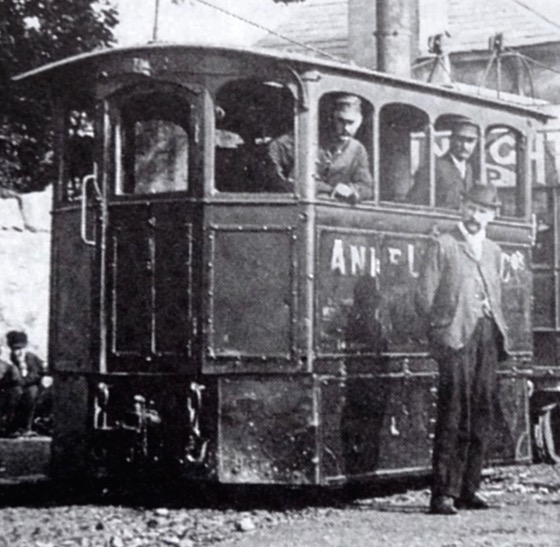
An enlargement of the above photograph showing the driver and stoker/fireman, both of whom are wearing cotton jackets and railway-footplate style caps (without badges).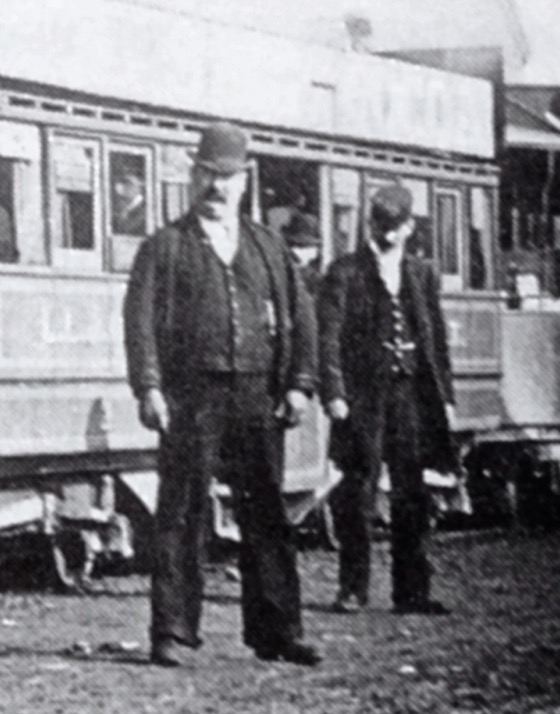
Another blow-up of the above photograph, this time showing the figure (on the right) in smart three-quarter-length jacket, waistcoat and kepi-style cap. He is probably the conductor, though clearly lower in rank than the rather intimidating and thick-set individual in the foreground, who is probably a manager or a foreman.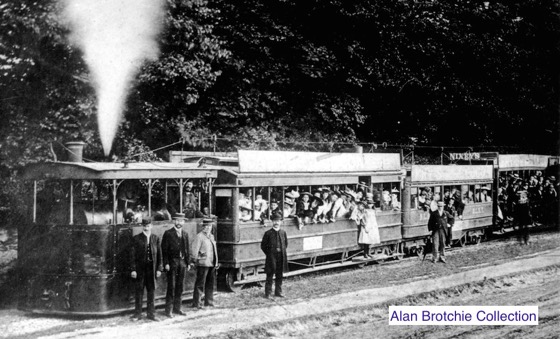
An evocative image — taken circa 1895 — of two school excursion trains (the second is out of shot to the right) at Ballydowd. The engine is one of the larger Kitsons, No 6. 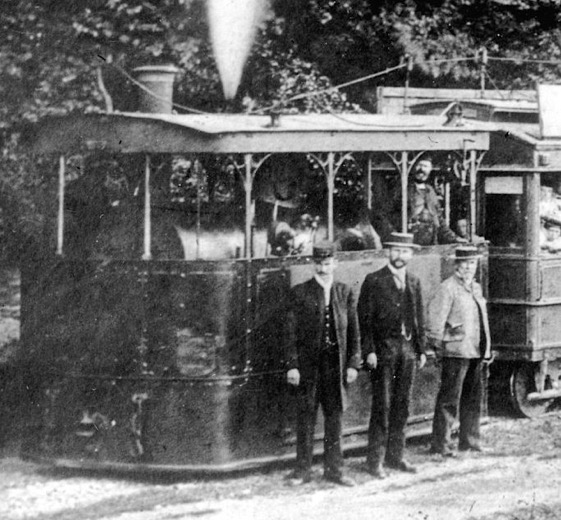
An enlargement of the above photograph showing the engine driver and fireman/stoker aboard No 6, both in railway footplate-like attire. The figure in the kepi-style cap and long coat is probably a conductor, though he could equally well be an inspector or even a station master.
Motormen and conductors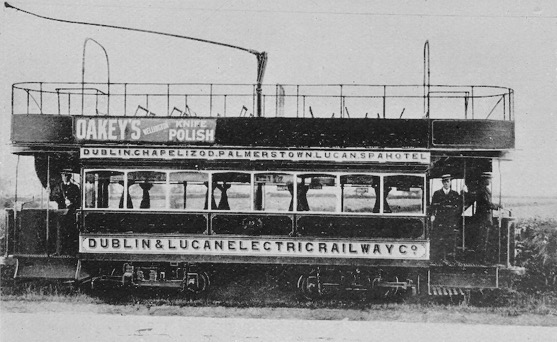
A staged shot intended to show the distinctive curved trolley boom of one of the new electric cars, this example being No 15. With thanks to the National Tramway Museum. 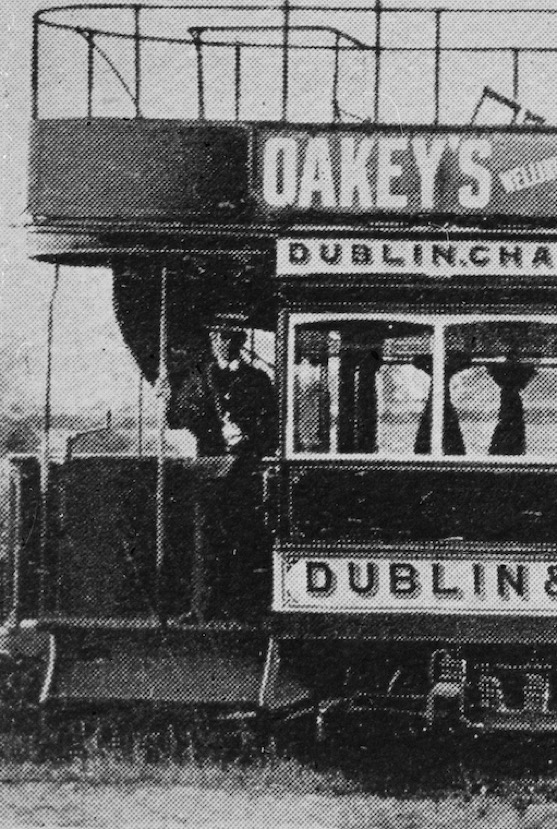
An enlargement of the above photograph, which although of poor quality, does show that the conductor is wearing a single-breasted jacket with lapels, and a straw boater, the latter being a particular favourite of Dublin tramway systems during the summer months. 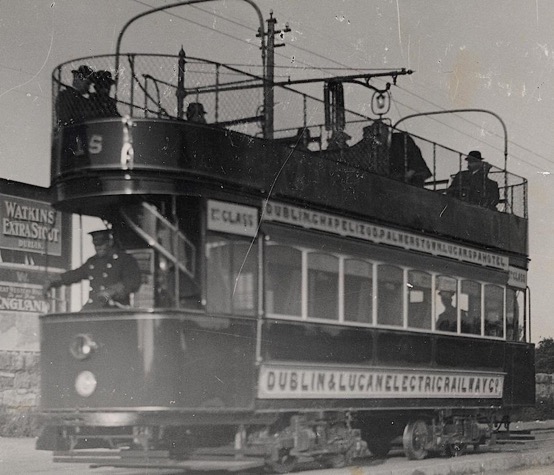
A motorman at the controls of Dublin and Lucan Electric Railway Company No 15 — photo undated, but judging by the pristine condition of the tram, probably taken in the early-to mid Edwardian era. He is wearing a lancer-style tunic and tensioned-crown peaked cap. Author's Collection.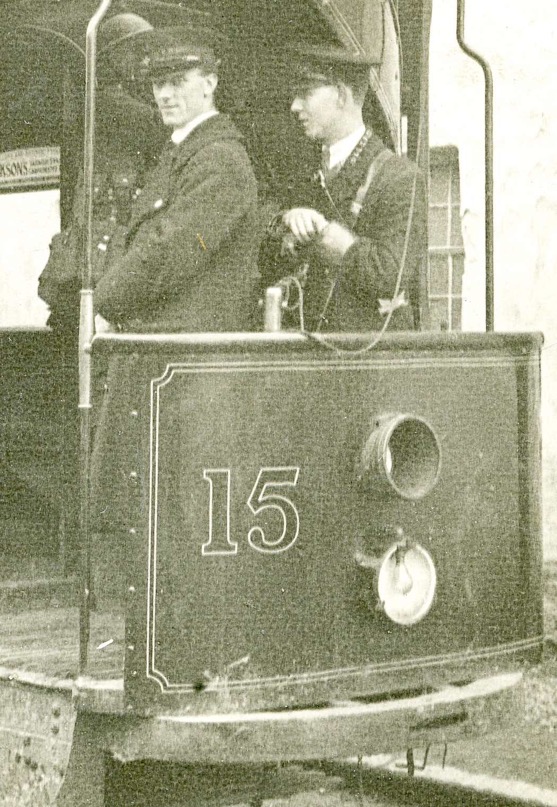
The crew of D&LER No 15 wait whilst their tram is searched by British soldiers — 1921. Both men are wearing tensioned-crown peaked caps, and hat bands bearing embroidered system initials. The conductor's jacket collar also bears initials, though precisely which, is unclear. The original photograph is believed to be held by the National Museum of Ireland.